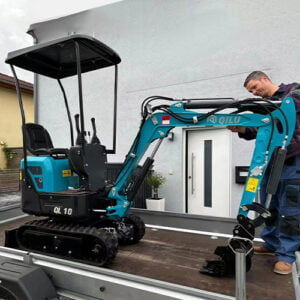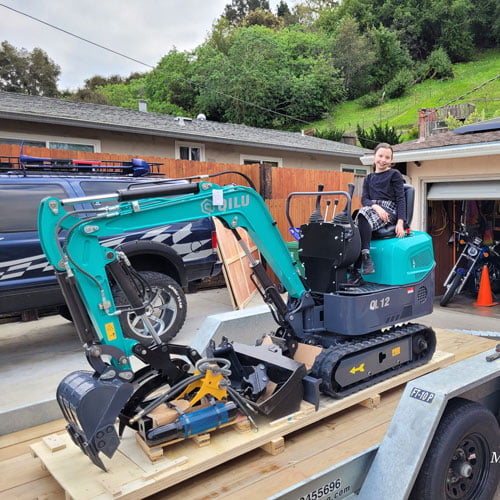Bienvenido a mi blog
Estoy encantada de tenerte aquí. Antes de sumergirnos en el contenido, me encantaría que te unieras a mí en mis plataformas de medios sociales. En ellas comparto mis ideas, me relaciono con una comunidad increíble y te mantengo al día de las últimas novedades. Aquí tienes cómo mantenerte conectado:
📘 Facebook: Conéctate conmigo en Facebook
🔗 LinkedIn: Sígame en LinkedIn
▶️ YouTube: Canal de fabricantes de tractores,Canal de fabricantes de excavadoras
🎥 TikTok: Fabricante de tractores,Fabricante de excavadoras
Emprendamos juntos este viaje. Espero que encuentres el contenido interesante, atractivo y, lo más importante, valioso. Exploremos, aprendamos y crezcamos.
Índice
Introducción
En miniexcavadora vs skid steer debate remains a key consideration for contractors choosing compact equipment. While both machines excel in different scenarios, understanding their distinct capabilities is crucial for optimizing productivity. The mini excavator vs skid steer comparison reveals clear differences in digging performance, maneuverability, and job site versatility that directly impact efficiency.
This miniexcavadora vs skid steer analysis focuses on practical operational factors rather than just specifications. We’ll examine how each machine performs in real-world conditions, helping you determine whether a mini excavator vs skid steer better suits your projects. The choice ultimately depends on your specific needs – from excavation depth requirements to material handling demands.
Operational Performance and Job Site Efficiency
The productivity comparison between miniexcavadoras and skid steers begins with their fundamental operating characteristics. Mini excavators feature a purpose-built design focused on excavation efficiency, with optimized weight distribution and hydraulic systems engineered for digging power. The undercarriage design positions the majority of the machine’s weight directly over the tracks during digging operations, creating superior stability that translates into more efficient material removal. This becomes particularly evident when examining digging depth capabilities, where even compact 1-2 ton mini excavators can outperform larger skid steers in vertical excavation.
Skid steers adopt a completely different operational approach that prioritizes rapid task switching and material handling efficiency. The vertical lift path design of modern skid steers provides improved load retention compared to older radial lift models, but still can’t match the digging depth and precision of mini excavators. Where skid steers gain an advantage is in applications requiring frequent transitions between different tasks. The standardized universal attachment system allows operators to switch from a digging bucket to pallet forks or other implements in minutes, creating workflow efficiencies that mini excavators can’t match for certain applications.
The hydraulic systems tell an important story about each machine’s capabilities. Miniexcavadoras typically employ multiple hydraulic pumps with sophisticated control valves that enable smooth, coordinated movements of the boom, arm, and bucket. This precision comes at the cost of attachment versatility – while mini excavators can power various attachments, they generally can’t match the high-flow hydraulic capabilities of premium skid steer models designed to run demanding attachments like cold planers or forestry mulchers.
Productivity Comparison Table
| Performance Metric | Miniexcavadora | Skid Steer |
|---|---|---|
| Profundidad máxima de excavación | 10-14 feet | 6-8 pies |
| Typical Cycle Time (loading) | 20-30 seconds | 15-20 seconds |
| Velocidad de desplazamiento | 2-3 mph | 8-10 mph |
| Lift Capacity (at 50% height) | 1,000-3,000 lbs | 1,500-3,500 lbs |
| Fuel Consumption/Hour | 2-3 gallons | 1.5-2 gallons |
| Attachment Change Time | 5-10 minutes | 1-3 minutes |
Job Site Adaptability and Working Conditions


When evaluating job site adaptability in the miniexcavadora vs skid steer debate, several key differences emerge. The mini excavator’s tracked design provides clear advantages in the mini excavator vs skid steer comparison for unstable terrain, offering superior weight distribution that creates ground pressures as low as 3-4 psi. This makes the mini excavator the preferred choice in the mini excavator vs skid steer matchup for soft surfaces or sensitive landscapes where skid steers might struggle.
En miniexcavadora vs skid steer performance gap becomes particularly evident on slopes, where mini excavators maintain stability on grades that would be hazardous for skid steers. However, in the mini excavator vs skid steer evaluation for flat, prepared surfaces, skid steers demonstrate superior speed and agility. The mini excavator vs skid steer comparison also reveals that skid steers adapt better to extreme cold conditions, while mini excavators typically offer better operator protection from weather elements.
Dust control represents another important factor in the mini excavator vs skid steer analysis, with mini excavators generating less airborne particulate matter than skid steers during operation. This mini excavator vs skid steer difference can be crucial for urban projects or environmentally sensitive areas. Ultimately, the mini excavator vs skid steer decision for job site adaptability depends on specific terrain challenges and environmental conditions.
Economic Considerations and Long-Term Value

When comparing the financial aspects of mini excavator vs skid steer ownership, several key differences emerge in the mini excavator vs skid steer cost equation. The initial purchase price for both machines in the mini excavator vs skid steer comparison appears similar (25,000−25,000−60,000), but long-term value tells a different story in the mini excavator vs skid steer financial analysis.
The mini excavator vs skid steer resale value comparison shows mini excavators typically retain 60-70% of value after five years versus 50-60% for skid steers in the used equipment market. This mini excavator vs skid steer difference stems from greater demand for used mini excavators and their longer productive lifespan.
Maintenance costs in the miniexcavadora vs skid steer evaluation present an interesting contrast. While skid steers require less frequent undercarriage service in the mini excavator vs skid steer maintenance comparison, their rigid frames endure more structural stress. The mini excavator’s more complex but durable hydraulic system in the mini excavator vs skid steer matchup proves better suited for heavy digging cycles that would prematurely wear skid steer components.
Fuel efficiency in the mini excavator vs skid steer analysis shows skid steers generally consume less fuel per hour (1.5-2 gallons vs 2-3 gallons). However, the mini excavator vs skid steer productivity comparison reveals mini excavators often move more material per gallon when performing deep excavation work. This mini excavator vs skid steer efficiency factor must be weighed against your specific usage patterns.
The mini excavator vs skid steer total cost of ownership ultimately depends on your application frequency. For occasional users, the mini excavator vs skid steer rental option may prove most economical, while frequent operators will find better value in the mini excavator vs skid steer purchase decision. Careful analysis of your mini excavator vs skid steer usage patterns will determine which machine offers superior long-term value.
Conclusión
The decision between a miniexcavadora and skid steer ultimately depends on carefully matching machine capabilities to specific project requirements and business goals. Contractors specializing in site development, utility installation, or any work requiring significant excavation will find mini excavators deliver superior productivity and return on investment. Landscapers, demolition specialists, and material handling operations will likely prefer skid steers for their rapid work cycle times and superior material handling capabilities.
Forward-thinking contractors are increasingly recognizing the value of maintaining both machines in their fleets to maximize operational flexibility. This approach allows matching the right equipment to each task rather than making compromises with a single machine solution. As equipment technology continues to evolve, understanding these fundamental productivity differences remains essential for making informed equipment decisions that impact project success and profitability.
PREGUNTAS FRECUENTES
What are the primary tasks where a miniexcavadora outperforms a skid steer?
Mini excavators demonstrate clear superiority in deep excavation projects, precision digging near existing structures, and work on unstable or sensitive surfaces. Their extended reach and depth capabilities make them essential for utility work, foundation digging, and any application requiring careful material removal.
In what situations would a skid steer be the better productivity choice?
Skid steers excel in material handling operations, sites requiring frequent attachment changes, and projects involving substantial horizontal movement of materials. Their rapid work cycles and superior loader capabilities make them ideal for landscaping projects, demolition sites with extensive debris handling, and operations needing quick transitions between different tasks.
How significant is the operator experience difference between these machines?
The learning curve differs substantially. Skid steers are generally easier to operate at a basic level, with intuitive controls for loading and simple digging tasks. Mini excavators require more skill to operate efficiently, particularly for precision digging applications. However, experienced operators can achieve significantly higher productivity with a mini excavator in appropriate applications.
What are the insurance and liability considerations when choosing between these machines?
Insurance costs typically run slightly higher for mini excavators due to their greater digging depth potential and associated risks. However, skid steers have higher incidence rates of rollover accidents, particularly when operated by inexperienced personnel on uneven terrain. Liability concerns should factor into the decision, with mini excavators generally presenting lower risk in most excavation scenarios.
How do rental market dynamics affect the decision to purchase one machine over the other?
The rental market shows stronger demand for skid steers due to their broader applicability across various industries. This can make finding rental mini excavators more challenging in some markets during peak construction seasons. Contractors needing guaranteed access to excavation capabilities may find purchasing a mini excavator provides more reliable availability than depending on rental market fluctuations.




